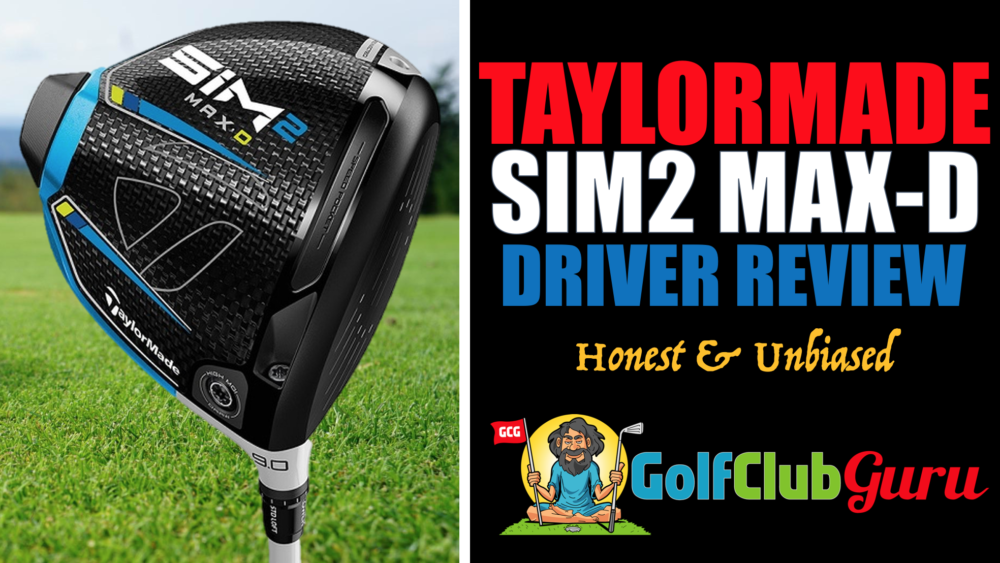If you are looking for a draw-biased driver, you now have lots of options to choose from. You’ve got lots of older models (with movable weights and with permanent heel-positioned weights) as well as brand new releases (Callaway Epic Speed DS, Ping G425 SFT, Cobra RADSPEED XD, etc.). It seems that practically ever brand is getting on board with draw-biased drivers to cater to the large crowd that struggles with their banana slices – and are willing to pay up to fix it.
The problem is: a draw biased driver won’t necessarily fix your slicing or missing to the right. Sure, it may cover it up (like a bandaid) or make your miss slightly less right, but it won’t fix it. The only way to actually fix an open club face at impact? A combination of swing changes and/or grip changes. Because you apparently have enough money to potentially buy the TaylorMade SIM2 Max-D driver ($500+), I’d highly recommend that you spend that money on lessons as opposed to a single band aid.
Ok. So glad that we got that out of the way. If you skimmed over the first two paragraphs, please read over them again. You wanted fair and unbiased thoughts – and that’s what you get from me.
Now, let’s move on to the actual review, shall we?
Performance & Appearance
If you are looking for an all-around beautiful driver, you came to the right place. I really like the contrast of the white/gray and black crown. On the flipside of the driver, you’ll see two weights. One weight is placed centered and far back on the club head for high launch and some added forgiveness. The second weight is what you really came here for. The second weight is as close to the heel as I’ve ever seen. The weight makes the toe of the club head much easier to naturally turn over, allowing you to close the club face and hit the ball squarely.
When it comes to performance, it will depend on you and your swing, obviously. In general, though, you can expect to see more straight (and even left misses) than your previous driver. The heel-positioned weight will definitely make the club face easier to square up at impact.
If high, towering draws like Rory is what you are looking for, then you came to the right review. And if you want lots of extra forgiveness on your off center hits, then the TaylorMade SIM2 MAX-D driver is exactly what you are looking for. The club face is significantly taller than the SIM2 and SIM2 MAX, leading to a larger sweet spot. If you tend to sky the golf ball with your current driver, that should happen a lot less frequently due to the taller club face.
It should go without saying though, that you need to get fitted for a driver if you want to optimize your distance and spin rate. So if you are going to spend $500 without getting fitted, then you are potentially wasting money and missing out on performance. But if you don’t want to mess with getting fitted and just want a super forgiving, high launching driver with lots of forgiveness and a draw bias, the SIM2 MAX-D is the one for you.
Pros & Cons
Pros:
- super high launching, which most golfers (with slow to average swing speeds) will benefit from
- draw biased, which will help straighten out drives for those that slice and miss to the right (if right handed, of course)
- taller club face to prevent skying a drive and to add overall forgiveness by increasing the sweet spot
- aerodynamic shape and lots of features (speed pocket, inertia generator, blah blah blah) to increase ball speed
- 4 degree loft sleeve (can add or decrease up to 2 degrees of loft)
Cons:
- You just need to pay $530 + tax + fitting fee + possible shipping (outrageous price for a single club when there are FAR better value alternatives)
- Your club will be outdated and severely devalued in about 6 months when the SIM3 comes out and demand drops off a cliff
- permanent draw-bias, so you’ll always have to deal with it even after you fix your slice-causing swing flaws
Who It’s Best For
If you want a super forgiving, high flying driver with a huge sweet spot and a draw bias, the TaylorMade SIM2 MAX-D is the driver that you are looking for…. but only if you can afford it. Like I mentioned earlier, the driver will cost you $530 + taxes/shipping/fees. If you are OK with spending that kind of money on a single club, then more power to you. This driver will stay up with date with technology for 5-10 years, so you shouldn’t really need to upgrade until the next decade.
If you don’t want the draw bias, then stick with the SIM2 Max. If you want a low launching, low spinning driver (ideally for faster swing speeds), then stick with the SIM2 (standard).
If you really want this driver, but don’t want to spend your hard earned moolah, then carry on to the bottom section of this review for a better priced alternative that will perform practically the same.
Comparison To Other TaylorMade SIM2 Drivers
The SIM2 series of drivers has three models: SIM2 (a low spin head for faster swing speeds), the SIM2 Max (for a great combination of distance and forgiveness), and the SIM2 MAX-D (for a high launching, forgiving club head with a draw bias).
Compared to the SIM2 and SIM2 Max, the TaylorMade SIM2 Max-D driver is:
- FAR higher launching than the SIM2, and decently higher launching than the SIM2 Max
- more forgiving than the other two
- more left-favoring (draw biased) than the other two
- the only driver of the three that you probably won’t ever see being used on tour (they don’t need or want a draw bias)
- taller than the other two when it comes to the club face size
- better for beginners that struggle with slicing and leaving the club face open at impact
- longer off the tee than the others (only if you struggle with missing right, though). If you don’t struggle with missing right, then the MAX will be just as long.
Alternative To Save Money
I’m always on the look out for a great performing driver that will perform just as well at the new releases, but at a SMALL FRACTION of the price.
The best alternative to the TaylorMade SIM2 Max-D? The TaylorMade M2 D-Type. Yes, you guessed what the D stands for. The TaylorMade M2 D-Type driver is a forgiving, high launching, draw-biased driver just like the SIM2 Max-D. While you can’t see the heel-positioned weight on the M2, it is in fact hidden under the crown to make the club face easier to turn over.
The main differences between the two? The color scheme, the name (barely), and the price tag. While a SIM2 Max-D will set you back $500+, you can buy a slightly used M2 D-Type driver for around $150. The choice literally has never been easier to NOT buy a new release. They all work practically the same as long as they were made by a premium brand and released in the past 5 years or so.
Did you like my review of the TaylorMade SIM2 Max-D driver? Let me know below!







This review was great for me. I recently went to a Taylor Made Demo Days Fitting. They said that this was the club for me. Never did a Demo before this. I wanted to know why this was the club for me!. You explained why I hit every ball within a 16 yd pattern. The Club was designed that way. I am looking for a Club for a Beginner who has had a few lessons (6) to learn to swing the Clubs correctly.
Thank You for Your expertise & review. I will be looking at your sight for more advice.
Steve Long Drive.
50/50- seemed more like an opinion piece versus data and technology intel on the drivers. Seemed to be hung up on price, if you don’t believe newer technology can improve your shots, then why are are newer materials used and machining technologies changed- to improve the clubs.
I think the review walks people down a path of don’t be fooled by newer released clubs, instead spending time understanding what they can do for a wide range of players- low handicapped to high.
Your review was what others have said basically. I am a Taylormade guy and like their clubs. Reshafted my R1 Black and after many years the adapter fractured and since the shaft and head and adapter were all very old decided on a new driver. I ply 4 times a week or more. So lots of miles on the R1. Tried finding a New R1 of course. Well why should I buy a used one as do not know what has been done or how much use it has. Bought the Sim max 2 D and well it last me if it does half of what you say it will do. thanks for the review